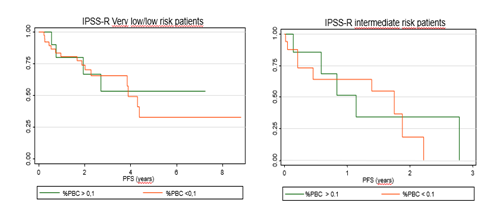
Contributions
Abstract: PB1928
Type: Publication Only
Background
Recently, an immunosuppressive enviroment with low number of precursor B cells at the bone marrow has been related with poor survival in patients with very low/low and intermediate risk myelodysplastic syndrome (MS), but this negative impact is unclear yet.
Aims
The objetive of this study is to establish if there is an negative association between the percentage of precursor B cells (%PBC) at the time of diagnosis of MS and progression-free survival.
Methods
We analyzed 48 patients with IPSS-R very low/low risk (VL/L) and 34 patients with intermediate risk (INT) in the past 10 years in a single institution in Spain. We reviewed the %PBC CD34+ (CD34+CD10+ or CD34+CD117-) over total marrow cells at diagnosis measured by flow cytometry, and we calculated the time of progression-free survival (PFS) defined as the time between inclusion until progression to refractory anemia with excess blasts type 2 (RAEB-2) or acute myeloid leukemia (AML). The Competing risks regression test was used to assess the predictive value of PBC in relationship to PFS.
Results
Median age in both groups was 69 years, and median of progression to RAEB-2 or AML was 1,96 years in VL/L group and 0,64 years in INT group. The %PBC was not a predictor of PFS in VL/L group with a sub-hazard ratio (SHR) of 0,23 (95% CI: 0,003-13,96, P=0,485) neither in the INT group with a SHR 0,14 (95%CI: 0,001-4,52, P=0,211). We also performed a median split analysis fo the %PBC with a median value of 0,1% in both groups. In the VL/L group, patients with a %PBC above the median had a median PFS of 2,48 years versus 1,99 years for the patients with %PBC below the median. In the INT group, patients with a %PBC above the median had a median PFS of 1,14 years versus 0,83 years for the patients with %PBC below the median.

Conclusion
Our results not provide evidence in order to establish a prognostic value between %PBC at diagnosis in IPSS-R very low, low or intermediate MS.
Session topic: 10. Myelodysplastic syndromes - Clinical
Keyword(s): prognosis, Progenitor cell, Myelodysplasia
Abstract: PB1928
Type: Publication Only
Background
Recently, an immunosuppressive enviroment with low number of precursor B cells at the bone marrow has been related with poor survival in patients with very low/low and intermediate risk myelodysplastic syndrome (MS), but this negative impact is unclear yet.
Aims
The objetive of this study is to establish if there is an negative association between the percentage of precursor B cells (%PBC) at the time of diagnosis of MS and progression-free survival.
Methods
We analyzed 48 patients with IPSS-R very low/low risk (VL/L) and 34 patients with intermediate risk (INT) in the past 10 years in a single institution in Spain. We reviewed the %PBC CD34+ (CD34+CD10+ or CD34+CD117-) over total marrow cells at diagnosis measured by flow cytometry, and we calculated the time of progression-free survival (PFS) defined as the time between inclusion until progression to refractory anemia with excess blasts type 2 (RAEB-2) or acute myeloid leukemia (AML). The Competing risks regression test was used to assess the predictive value of PBC in relationship to PFS.
Results
Median age in both groups was 69 years, and median of progression to RAEB-2 or AML was 1,96 years in VL/L group and 0,64 years in INT group. The %PBC was not a predictor of PFS in VL/L group with a sub-hazard ratio (SHR) of 0,23 (95% CI: 0,003-13,96, P=0,485) neither in the INT group with a SHR 0,14 (95%CI: 0,001-4,52, P=0,211). We also performed a median split analysis fo the %PBC with a median value of 0,1% in both groups. In the VL/L group, patients with a %PBC above the median had a median PFS of 2,48 years versus 1,99 years for the patients with %PBC below the median. In the INT group, patients with a %PBC above the median had a median PFS of 1,14 years versus 0,83 years for the patients with %PBC below the median.

Conclusion
Our results not provide evidence in order to establish a prognostic value between %PBC at diagnosis in IPSS-R very low, low or intermediate MS.
Session topic: 10. Myelodysplastic syndromes - Clinical
Keyword(s): prognosis, Progenitor cell, Myelodysplasia


